
I recently stumbled across an interesting article on risk perception: If It’s Difficult to Pronounce, It Must Be Risky – Fluency, Familiarity and Risk perception. Researches from the University of Michigan had students read lists of fictious words and imagining that they were reading food lables and judge the hazard of each ingredient form very safe to very harmful. The words were divided in groups of easy-to-pronounce words (such as Magnalroxate) and difficult-to-pronounce words (i.e. Hnegripitrom). If I were to take the test I’d probably rank Magnalroxate as worse than Hnegripitrom – the “roxate” somehow reminds me of a pesticide or something like that. It turned out however (as expected) that substances with difficult-to-pronounce names were perceived as more harmful than substances with easy-to-pronounce names.
The result of the study is quite unfortunate, and chemists face a communication challenge here. When chemists give name to molecules they follow conventions agreed upon by IUPAC for systematic names. This can sometimes lead to extremely long and unpractical names, hence the use of trivial names. To give you an example of this glucose has the systematic name (2R,3R,4S,5R,6R)-6-(hydroxymethyl)-tetrahydro-2H-pyran-2,3,4,5-tetraol. If one where to judge by difficulty of pronounciation consuming this one should be pretty risky. On the other hand the compound known under the trivial name mustard gas could sound like a volatile cousin of Dijon mustard but is in fact a blistering agent, used in chemical warfare. The take home message is: Don’t judge a molecule by it’s name!
Talking about risk perception, the article reminded me of the warnings against the dangerous chemical DHMO, also known as dihydrogen monoxide. To read everything about the risks, visit the DHMO website. To read a little background information about the hoax, start with the wikipedia entry on the dihydrogen monoxide hoax. In case you’re lazy and don’t bother to check the links: dihydrogen monoxide is simply am uncommon scientific name for water. But don’t be lazey, the DHMO website is actually quite amuzing 🙂
[Article on risk perception was found via CEN blog]

Love this posting! The IUPAC naming drives me crazy! Have you ever read the material data safety sheets (MSDS) for common food ingredients like water, glucose, or salt (NaCl)? You would think this stuff would kill you!
But you bring up a point that I have been vacillating over what my title should be as “The Sensitive Epicure” providing personal chef & recipe development services to food & flavor companies. Should I choose “Personal Chef & Organic Chemist”? Do people have a bad association of a chemist making food? Even if it is for special dietary needs?
Erin: I guess, for the lay person, “organic chemist” might sound quite comforting. That’s my impression when doing the introductory lessons on the topic for pre-service teacher students. “Organic chemistry” is often associated with “from the living world”, “healthy”, “natural”, …and “organic”. Might “colloid and surface chemistry” be somewhat more intimidating, maybe? A slight paradox, since this field is maybe among the most important to cooking. No, I’m not an colloid-/surface chemist, rather ORGANOmetallic 😉
Erik – I just found your blog, and love it! I figured “organic” is better to the lay person as opposed to “synthetic” or “material scientist”. Does the average person realize that DDT and other pesticides are by chemical definition “organic”? I think not. And let’s not tell them.
[…] Dangerous names […]
I think the “natural” moniker is worse than “organic.” I mean, strychnine and arsenic are all natural, but people just buy “natural” products thinking they’re somehow much better.
Erin: I put “Chemist & food enthusiast” on my Khymos business card 😉
i really confused about DHMO..it just an hoax isn’t it?
how come water molecule become hafmful
Yes – the DHMO page is a hoax 🙂